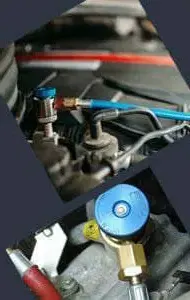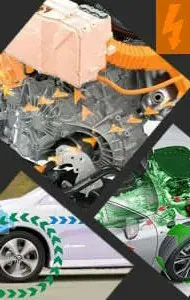F-Gas

Course Overview
All Mobile Air Conditioning (MAC) technicians working with cars and car derived vans, must have achieved as a minimum requirement, a refrigerant handling qualification which fulfils the European Union F-gas Regulation (EC842/2006 and Annex to Regulation EC307/2008 and EU517/2014).
This e-learning course together with a practical part, provide to experienced automotive Mobile Air Conditioning (MAC) technicians the knowledge to successfully face the assessment to obtain the corresponding F-GAS Certificate / IMI L3 Award in Automotive Refrigerant Handling (http://www.imiawards.org.uk/Qualifications/L3-Award-in-Automotive-Refrigerant-Handling-EC842-2006).
Learners must demonstrate the learning outcomes by following and achieving two assessment components which are set by IMI: Practical assessment & External online test.
Successful candidates will be issued with a certificate which shows they are compliant and therefore are allowed to carry out following activities: installation, maintenance, and inspection (including leak checks, charging, and recovery of fluorinated refrigerants) and handling of gas containers.
Course Topics
Theoretical Content
1. Environmental impact of refrigerants and corresponding environmental standards
- Basic knowledge of pertinent environmental questions: Climate change and Kyoto Protocol. Depletion of the ozone layer and the Montreal Protocol. Potential ozone depletion and atmospheric warming, the use of fluorinated greenhouse gases (chlorofluorocarbons and non-chlorofluorocarbons) and other substances such as refrigerants, the impact on the climate and ozone layer of fluorinated greenhouse gas emissions (order of magnitude of their GWP and ODP). Use of alternative refrigerants.
- Pertinent provisions of Regulation (EC) n.º 1005/2009 of the European Parliament and Council, of 16 September 2009, Directive 2006/40/EC of the European Parliament and Council, of 17 May 2006, regarding emissions from air conditioning systems of motor vehicles, modified by Directive 70/156/CEE and Regulation (EU) 517/2014 of the European Parliament and Council, of 16 April 2014, on fluorinated greenhouse gases and the regulations that develop it.
- Commercialization of refrigerants, restrictions, record keeping and notification of information.
2. Introduction to refrigeration
- Matter and energy. Heat as a form of energy. Heat transfer mechanisms.
- Thermodynamic parameters. Components of a saturated vapour cycle cooling system.
- Thermal and functional description of an air-conditioning system.
3. Refrigerants
- Types, properties, and specific characteristics of refrigerants and oils used in vehicle climate control systems. Future systems and refrigerants, including R1234yf. Specific considerations in the handling of the different systems.
4. Basic repair equipment
- Pressure measurements. Temperature measurements. Effects of moisture.
- Refrigerant recovery system. Vacuum system and components.
- Charging station: components. Operation or leak detectors.
- Pressure measurements Temperature measurements.
- Operation of the vacuum pump. Operation of charging stations.
- Carrying out guided charge processes. Leak verification.
5. Air conditioning system
- Liquid evaporation systems. Liquid flood systems.
- Installation hydraulic system. Installation mechanical system. Installation electrical system.
- Commonly-used vocabulary in the sector.
- System connections. Interpretation of diagrams. Identification of symbols.
- Measurement and identification of connections.
6. Compressors
- Systems to connect to the engine. Connection requirements with the A/C system.
- Alternative compressors: fixed volume, variable volume.
- Rotating compressors: spiral vane.
- Compressor regulation mechanisms Types of clutches. Verification.
- Compressor identification practice. Clutch dismantling. Checking of clutch condition.
- Disassembly/assembly of a compressor.
7. Condensers / evaporators
- Heat exchangers. Functioning Maintenance criteria. Types of evaporators Condenser models.
- Assembly and disassembly criteria.
8. Expansion valve
- Functioning and types. Adjustment mechanisms. Installation conditions.
9. Dehydration filters
- Functional characteristics. Drying agent High-pressure configurations.
- Types of low-pressure accumulators.
- Installation characteristics. Replacement requirements.
10. Electric fans
- Types of fans in the A/C Arrangement and work loads. Replacement and repair. Management of the electric fan by pressure. Types of pressure switches. Verification of the pressure switch. Verify functioning. Adapt reversible electric fan to work as blower or suction fan.
11. Control and safety devices
- Evaporator thermostat: mechanical. Electronic.
- Safety pressure switches. Radiator/engine temperature switches. External temperature sensors. Disassembly and replacement conditions. Regulating a thermostat.
12. Electrical installation for the air conditioning
- Fundamental elements in the electrical installation. Control points and consumption points. Relays: functioning and inspection. The identification of a relay as an electromagnetic and control element Breakers. Basic circuit. Complete circuit. Insulation and connectors.
- Relay identification. Verify continuity in the circuit. Interpretation of electrical diagrams.
- Connections characteristics: Adequate use of terminals. Use of connectors.
13. Electronic climate control
- The concept of climate control. Automation of climate control. Sensors and actuators. Universal control units.
- Technical control units Climate control levels. Multizone and multiservice systems.
- Location of sensors. Verification of control units Self-diagnostics and diagnostics using external tools.
14. Charging of the air conditioning circuit
- Need to charge a circuit. Verification of the system. Maintenance of systems.
- Identification of vehicle refrigerant. Care in handling and differences between refrigerants.
- Refrigerant recovery.
- Legal and environmental requirements.
- Recycling of A/C refrigerant Process of draining an A/C circuit.
- Charging an A/C circuit. Refilling oil in an A/C system Preparation of tools.
- Recovery process and circuit verification. Vacuum: purpose and precautions.
- Charging a system knowing or not knowing the exact quantity.
15. Fault diagnostic and repair
- Leak diagnostic. Compressor diagnostic. Performance diagnostic.
- Electric fault diagnostic. PLC diagnostic. Cleaning circuits Detecting and repairing leaks. Electrical fault repair. Detect the source of performance faults. Compressor repair. Cleaning of circuits.
16. Alternative technologies to replace or reduce the use of fluorinated greenhouse gases and the safe way to handle them
- Safety conditions when handling these technologies.
Practical Content
1. Procedures for recovering fluorinated greenhouse gases.
2. Handle a refrigerant cylinder.
- Safe handling of refrigerant cylinders.
- Safe transfer of refrigerant to or from a cylinder.
3. Connect and disconnect a recovery set to and from the Service ports of a motor vehicle A/C system containing fluorinated greenhouse gases.
- Identify the type of refrigerant being used on a vehicle.
- Locate and identify the A/C system service ports on a vehicle.
- Demonstrate the correct procedure for connecting and disconnection of the recovery set to and from the service ports of a motor vehicle.
4. Operate a recovery set.
Average Duration
23 hours
Access This Course
Get access to this course and 30+ more topics by subscribing.
Subscribe to Access All Online Courses
We provide access to all of our online courses for 12 months with a one-time purchase.
£199 ex.VAT per year


